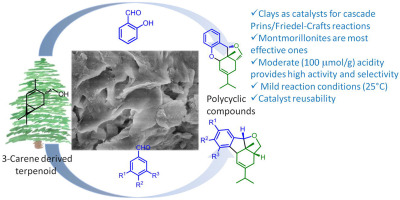The article with participation of NIOCh's researchers is published in Applied Catalysis A: General (IF=5.706)
Clays catalyzed cascade Prins and Prins-Friedel-Crafts reactions for synthesis of terpenoid-derived polycyclic compounds
A.Yu. Sidorenko, Yu.M. Kurban, A.V. Kravtsova, I.V. I'ina, N.S. Li-Zhulanov, D.V. Korchagina, J.E. Sánchez-Velandia, A. Aho, K.P. Volcho, N.F. Salakhutdinov, D.Yu. Murzin, V.E. Agabekov
Applied Catalysis A: General
Volume 629, 05 January 2022, 118395
https://doi.org/10.1016/j.apcata.2021.118395

Abstract
The Prins/Friedel-Crafts cascade reactions of the terpenoid trans-4-hydroxymethyl-2-carene (synthesized from 3-carene) with aromatic aldehydes were systematically studied for the first time on acidic mesoporous clays (halloysite, illite, montmorillonites). Both the reaction rate and selectivity to the desired polycyclic product with tetrahydrofuran moiety increased with an increase in the catalyst acidity and their drying temperature, indicating that relatively strong Brønsted and Lewis acid sites favored their formation. The best activity and selectivity (up to 97%) was demonstrated over commercial montmorillonite K-10 with acidity of ca. 100 μmol/g. In contrast, on strongest acids (resin Amberlyst-15), dehydration/aromatization of the substrate was observed. It was shown, that mesoporosity of the catalyst is one of the key factors governing catalytic behavior. The presence of at least one an electron-donor substituent at the meta-position of benzaldehyde is critical for the Prins-Friedel-Crafts reaction. Overall, available montmorillonites are an effective replacement for homogeneous catalysts for the Prins/Friedel-Crafts cascade reactions.
Альметрики:


